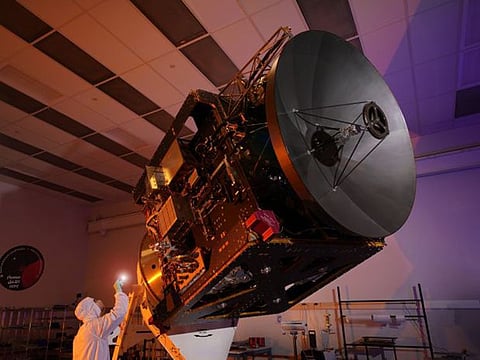UAE’s Hope Probe will monitor Martian weather for a full year
Mission will also help scientists understand how planet has lost its atmosphere

Dubai: The UAE’s Hope Probe to Mars will monitor the Martian atmosphere for a year to help scientists not only understand the weather but also how Mars has lost some of its atmosphere over billions of years of planetary history.
These revelations came in an article on Space.com shared via the Dubai Media Office on twitter on Monday.
In it, the article stated that the UAE could become the fourth or fifth country to orbit Mars next February if all goes well with this summer’s launch, but insight into the real mission behind the mission is what is new.
“We’re not there just to declare arrival to Mars,” said Sarah Al Amiri, science lead for the mission and the UAE’s minister of state for advanced sciences. “It doesn’t really make sense to call it planetary exploration and just make it about technology demonstration and about arrival.”
“There was a large gap in the complete understanding of the atmosphere of Mars,” she added. “We don’t have a full understanding of the weather system of Mars throughout an entire year.”
‘Previous and current missions have gathered observations of the Martian weather, but only a couple of times throughout a day, Al Amiri said. These measurements have often come from surface missions and so are quite limited geographically. Weather is too complex and interconnected for scientists to really get a handle on how it works from such piecemeal data,’ read the article.
So, Hope aims to monitor what’s happening in the Martian atmosphere for a full local year, including making connections between layers of the atmosphere. That will help scientists understand not only Martian weather, but also how Mars has lost some of its atmosphere over billions of years of planetary history.
“That science was a sweet spot for us,” Al Amiri said. “You’re complementary to other current missions, so you maximise the benefit that scientists are going to get globally from this mission, because it feeds into the current areas of research and expands on human knowledge as a whole.”
‘The goal of integrating data collected across layers of the Martian atmosphere means that Hope’s three instruments — a camera sensitive to optical and ultraviolet wavelengths and spectrometers tuned to infrared and to ultraviolet light — need to take simultaneous measurements that scientists can stack together,’ explained the article.
To facilitate that process, Hope carries all its instruments on the same arm. The spacecraft also has a precisely tuned 55 hour–long orbit that enables two different views of Mars: One in which the planet rotates beneath the spacecraft, and one in which the spacecraft keeps pace and watches the same spot over time, Al Amiri said. That combination of views should make it easier for scientists to put together a complete map of the Martian atmosphere, she added.
Hope is scheduled to launch in late July or early August — the same window targeted by NASA’s Perseverance rover and China’s first Mars mission, Tianwen.
Until March, the European Space Agency and Russia were also planning missions, but parachute problems and coronavirus travel restrictions have pushed that mission to 2022.
The UAE's Hope Probe arrived at its launch site in Japan as planned last month.
Sign up for the Daily Briefing
Get the latest news and updates straight to your inbox

